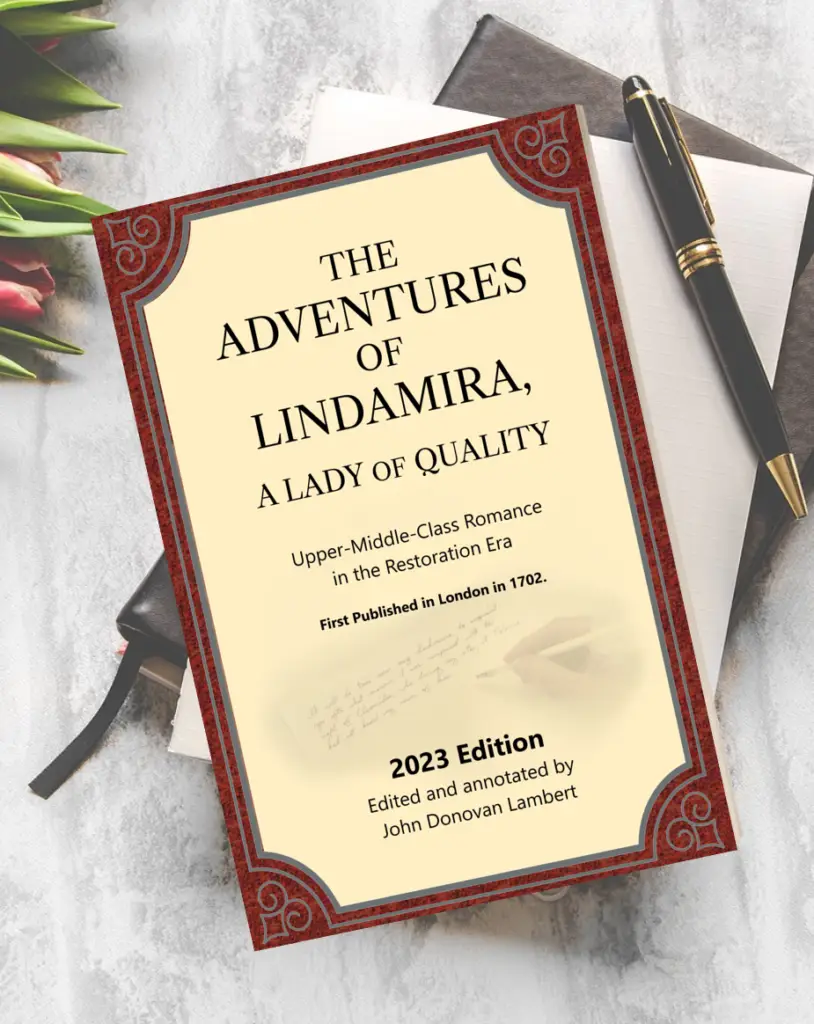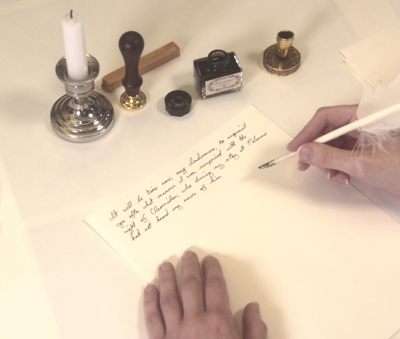The Adventures of Lindamira

The Adventures of Lindamira
is one of the oldest romance novels originally written in English, perhaps the first, and was first published in London in 1702.
The 2023 edition has been lightly modernized, with annotations and commentary added by John D. Lambert, and is available in paperback, hardcover, eBook, large print, an OpenDyslexic font versions, and an audiobook version is in preproduction.
- What Makes Lindamira a Great Story?
- What Else Makes Lindamira So Special?
- 2023 Introduction
The Adventures of Lindamira mimics the best of popular late 17th-century French, Spanish, and Italian novels of aristocratic romantic intrigues, with all the emotional ups and downs and the issues that build angst and anticipation to make a riveting tale, yet this story is far more concise, brings the cultural setting down to the upper-middle-class, and provides an innovative true-to-life perspective while including entertaining homages to its foreign-language predecessors’ unrealistic tales.
Lindamira is young, beautiful, wealthy, independent-minded, and virtuous, but not always as kind and rational as she desires to be. Multiple suitors of various quality pursue her, but the courtship process can be painful and confusing even when things go well, and often they don’t go well. Reflecting back on her life, she confides the details in 25 letters to her trusted friend Indamora.

- Possibly the first romance novel written in English
- A 300-year-old authorship mystery
- One of the oldest English romance novel written as contemporary that became historical
- Inspiration for what may be the first fan fiction based on an English romance novel
- An 18th-century international best-seller
This image is of an actress using a goose quill to write Letter 9 on traditional laid paper of the same type as used in 1700 England. This paper would have been folded and sealed without using a separate envelope. The items at the top are a quill holder, inkwell, seal (stamp), wax stick, and a candle for melting the wax to seal the letter. A portion of this image was used on the cover of the 2023 edition.
If you enjoy historical romances, you want to read Lindamira… first written as a contemporary romance and now a completely authentic historical romance because it was written over 300 years ago!
This novel from 1702 is in the form of twenty-five letters from Lindamira to her close friend Indamora, in which she confides her romantic adventures, beginning when she was 16 years old. The book’s subtitle, A Lady of Quality, was a phrase of the time to refer to a virtuous woman. Even though Lindamira has character flaws which sometimes cause harm to herself or others, a desire of being virtuous is deeply ingrained in her.
Departing from the more established European romance novels in several ways, perhaps the biggest was that Lindamira was upper-middle-class instead of a member of the aristocracy, and the popularity of this book at the time may have been derived partly by giving many English women ideas about lifestyles they could admire and some could possibly aspire to. For all reasons combined, it was popular enough that it was reprinted multiple times over several decades.
This book was also reprinted under the title The Lover’s Secretary, where lover means someone with a romantic affection, and with no sexual meaning. In this case, the lover refers to the protagonist Lindamira, and the word is used throughout the book with the same meaning. The word secretary in the title means a person to whom a secret is entrusted, in this case, one of Lindamira’s most trusted friends, Indamora.
Lindamira is special for many reasons, including:
- It has an honored position in English literature for its early and influential role in the slow transition from foreign novels to novels originating in English, and beginning to bend and break many foreign novel traditions.
- It was noted for being more realistic and less drawn-out than the exaggerated romances which were then being translated into or imitated in English from Spanish, French, and Italian romances.
- It was the most popular of the first novels in English to be set in the middle-class world instead of the aristocracy, and it was an international best-seller for decades.
- It not only conveys an entertaining story, it’s also written in the entertaining formal social language from three centuries past.
The previous editor modernized the spelling and a few similar improvements for the modern reader, and I’ve provided footnotes for some of the most obsolete and obscure terms, and occasionally to add clarity, to make the story more enjoyable for young readers, and hope advanced readers can forgive the trespass. Footnotes usually only appear with the first use of a word or phrase.
If the names of the characters seem unusual to readers of modern English novels, they were very conventional in 1702 England, when most novels in English were translated from French, Spanish, and Italian novels without changing character names, and the first English novels originating in English heavily imitated the styles of the continental novels, including in the naming of characters. Although the author of Lindamira innovated in several important ways, character naming wasn’t one of them, perhaps to give Lindamira’s readers what they were accustomed to at the time. These character names are just one of the features that will transport you into the authentic world of early English novels.
Happy reading!
Lindamira Map
Spoiler Alert: Some notes for the pinned locations contain plot spoilers.
This custom Google map contains locations related to the 1702 romance novel The Adventures of Lindamira, the 1704 fan fiction short-story sequel Indamora to Lindamira, Lady Mary Wortley Montagu, who wrote Indamora, and someone who may have written Lindamira.
Subscribe to John D. Lambert’s email list:
Subscribe now and instantly receive a free eBook copy of Indamora to Lindamira, the world’s first fan fiction short story based on a romance novel!
Signing up is also free, and I’ll only use the list to make occasional announcements about my book projects.

